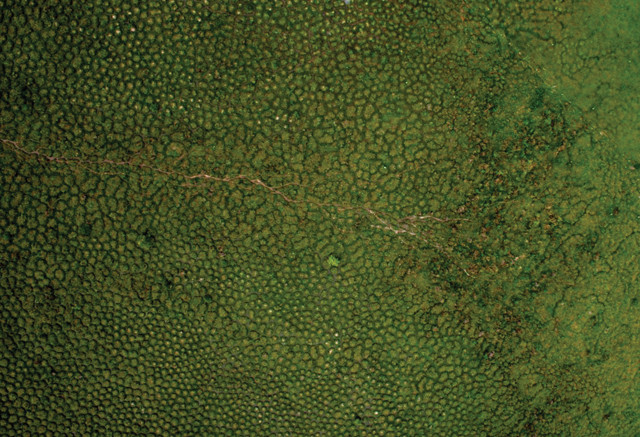
by Lauren Milideo Tuesday, August 16, 2016

Large mounds, called surales, dot the landscape in the Orinoco Llanos region of South America. Credit: Delphine Renard.
When researchers looking for archaeological remains in satellite imagery came across unidentified mounds — some as tall as humans — in the seasonally flooded wetlands of northern South America, they found a landscape shaped not by ancient civilizations but, rather, by modern earthworms.
“Imagine you go on Google Earth and see these mounds, and you have no idea where they came from or who built them,” says Anne Zangerlé, a soil ecologist at Germany’s Technical University of Braunschweig. To figure out the mounds’ origin, Zangerlé — lead author of a new study in PLOS ONE describing the mounds, called surales, and the unique landscapes where they’re found — and her colleagues traveled to the Orinoco Llanos region of inland Colombia.
Using drone-obtained aerial photographs, the team observed the range of mound sizes and shapes — up to 5 meters in diameter and 2 meters tall — as well as their extent and spacing. The team documented the features at field sites, consulted other researchers and past literature — similar mounds had been noted though not entirely described — then scrutinized Google Earth imagery to approximate the likelihood of surales occurring in portions of the Orinoco Llanos. They estimated that surales cover more than 75,000 square kilometers of Orinoco Llanos landscapes in both Colombia and Venezuela.
The team found that surales were located in seasonally flooded areas, including about half the total area studied in Colombia and Venezuela, although portions of the study area lacked sufficient satellite resolution to identify the mounds.
The team also took a closer look at the surales, studying their composition and biodiversity and confirming the mounds’ natural, rather than man-made, origin. Soil analyses revealed an unstratified mix of silica plant particles called phytoliths, which indicated bioturbation, as well as abundant worm casts — soils ingested and then left behind by earthworms. The researchers determined that the mounds are in fact built mostly from worm casts. Meanwhile, soils in the lower-lying and seasonally submerged basins between mounds contain far lower concentrations of casts, as well as less diverse assemblages of worm species. The mounds allow worms to escape flooded soils lacking oxygen, Zangerlé says.
In addition to housing an array of burrowing worms — most species found in the study were previously unknown, and members of the Andiorrhinus genus were most common — the mounds, as they develop, also host an increasing number of other plants and animals. They appear to show developmental stages, Zangerlé notes: While smaller mounds were covered just by grass, larger ones hosted a variety of plants, tall trees and insects in addition to worms.
The team showed, for the first time, “that these organisms are sort of single-handedly responsible for the development of an ecosystem type,” says Mac Callaham, a soil ecologist with the U.S. Department of Agriculture who was not involved in the study. The new species identifications are an important contribution, Callaham says: “We ought to know the name and identities of the organisms that are responsible for a whole ecosystem’s existence!”
The study makes another important contribution, says soil ecologist Patrick Lavelle, professor emeritus of Pierre and Marie Curie University in France, who was not involved in this study but was formerly Zangerlé’s doctoral advisor. “It’s a spectacular demonstration that soil organisms are in charge of constructing and maintaining the quality of the soil,” he says. The worms’ hidden work “improved the quality of their environment a lot, which allowed this very harsh environment to be very productive.” Lavelle notes that comparing existing surales sites with areas where surales formerly existed but which are now used for agriculture could reveal what remains of the natural interactions between worms and soil in the agricultural areas, which could in turn help workers develop agricultural systems that “respect this interaction.”
Zangerlé says developing models of the mounds would be an informative step in better understanding their formation and organization. Field experiments — perhaps removing a location’s mounds and then monitoring their reappearance — could also be useful, she says.
© 2008-2021. All rights reserved. Any copying, redistribution or retransmission of any of the contents of this service without the expressed written permission of the American Geosciences Institute is expressly prohibited. Click here for all copyright requests.